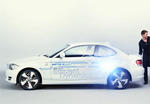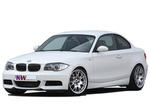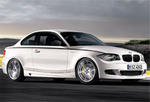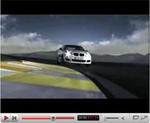
BMW released detailed information on the UK market version (right hand drive) BMW 1-Series Coupe. The BMW 1-Series Coupe will be available in the Great Britain in these versions: 135i, 120d and 123d .
The BMW 120d price starts at £21,585 and goes up to £24,705 for the BMW 120d M Sport Coupe.
The BMW 123d price starts at £24,855 and goes up to £26,290 for the BMW 123d M Sport Coupe.
The BMW 135i M Sport Coupe price for the UK market is £29,745.
BMW Press Release:
BMW Multi Model Launch
The new BMW 6 Series Coupe and Convertible
The new BMW 1 Series Coupe
Autumn 2007 sees BMW reinforce its position as the country’s number one premium car company.
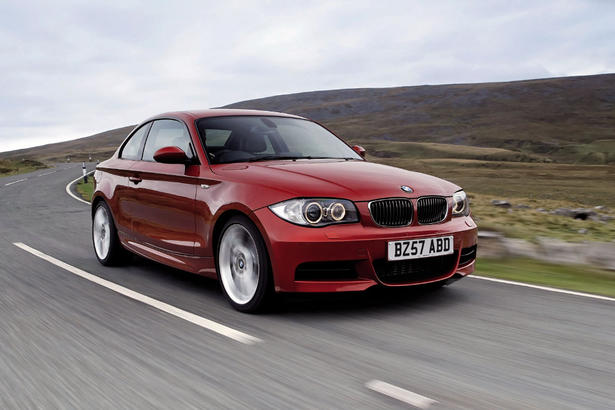
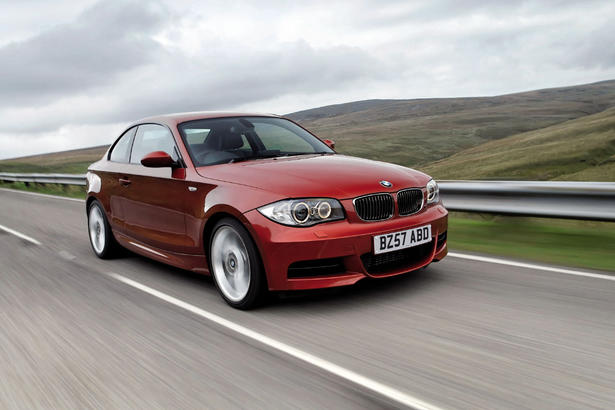
Exciting new products and leading emissions technologies are pushing BMW UK to another record sales year. With the launch of two brand new unique cars with a range of model derivatives featuring BMW’s EfficientDynamics technologies maintains BMW’s grip on the premium car market.
September saw the launch of the fast, yet frugal, BMW 520d. October marks the arrival of the BMW 635d, the world’s first diesel-powered luxury Gran Tourer. And November sees the launch of the striking BMW 1 Series Coupe.
Both 1 Series Coupe and 635d Coupe and
Convertible models stand alone in the marketplace and set new engineering benchmarks. Meanwhile, the range of BMWs with EfficientDynamics technologies continues apace. Power is up and fuel consumption and emissions down on all four-cylinder 3 and 5 Series and X3 models. No other car company can offer 18 per cent performance improvements on top of 24 per cent consumption and emission reductions.
The BMW 635d, 1 Series Coupe and new EfficientDynamics models offer today what others are aspiring
to in the future. From fuel-saving high-precision direct injection, lightweight materials and Brake Energy Regeneration to emission-reducing Auto Start-Stop. EfficientDynamics isn’t a single technology that affects one headline model. Rather, it has made a positive contribution to the performance and economy of every one of the 88 new BMW models launched in 2007.
More than 400,000 EfficientDynamics-equipped models will be on the world’s roads by the end of the year.
BMW 635d
The mating of a diesel engine and a luxury Grand Tourer
is arguably the perfect match for long distance, cross-continent cruising with minimal fuel stops. To achieve this level of performance the new 635d features the world’s most powerful three-litre diesel engine that still manages to record a combined fuel consumption of 40.9mpg. The award-winning engine is thus capable of powering a 635d for more than 600 miles between fill-ups. Such a unique package has resulted in the creation of an entirely new market segment.
BMW 1 Series Coupe
The BMW 1 Series Coupe sets a new benchmark in performance compact motoring. It can be powered by either the world’s most powerful 2.0-litre production diesel engine or the International Engine of the Year twin-turbocharged 3.0-litre petrol powerplant. The 123d Coupe and the 135i Coupe utilise EfficientDynamics technology to marry their intrinsic dynamic driving benefits with economical motoring to make for class-leading all-rounders. The brace of compact sports cars are joined by an even more economical 120d Coupe to round off the range.
EfficientDynamics models
BMW has always been at the forefront of motoring innovation. BMW’s EfficientDynamics-inspired models have extended the boundaries of all round drivetrain performance. In the UK 95 per cent of the models BMW offers now have some degree of EfficientDynamics technology fitted as standard.
In addition to the 1 Series Coupe and 6 Series Coupe and Convertible variants some of the latest models to come with the fuel saving and emissions-cutting innovations include four-cylinder variants of the 3 and 5 Series, and X3. While all 3 Series models now have EfficientDynamics measures fitted, it’s the smaller-capacity variants that record the most impressive figures compared to the outgoing models. For example, the 320d’s output rises from 163hp to 177hp while fuel consumption improves 19 per cent to 58.9mpg. CO2 emissions drop by 16 per cent to 128g/km.
Joining the improved 320d Saloon are new versions of the X3 2.0d and the 520d Saloon. The entry-level X3 now gets a 177hp diesel engine capable of a combined 43.5mpg, 11 per cent better than the previous model, and CO2 emissions that are cut by 10 per cent to 172g/km. It is also offered for the first time with BMW’s Steptronic automatic transmission with a minimal effect on day-to-day running costs compared to a manual.
The BMW 520d Saloon uses the same powerplant fitted to the X3 with a corresponding improvement in performance and economy compared to the model it replaces. Its combined consumption figure is now 55.4mpg while emissions are a 136g/km – enough to see the benchmark executive segment car fall into the Band C Vehicle Excise Duty tier.
Dr Norbert Reithofer, Chairman of the Board of Management of BMW Group, said at the IAA Frankfurt in 2007: “Unlike competitors who have recently unveiled a token car, or even a concept car, to highlight efficient motoring, BMW’s EfficientDynamics is applied to our entire model portfolio. In other words, we can achieve reductions for both small and large vehicles.
“All models available with BMW EfficientDynamics today are the result of seven years of development. Back then, climate protection was not on the agenda of politicians, nor the media, not the general public – but it was on our agenda at BMW.”
Jim O’Donnell, Managing Director of BMW UK, added: “Since its launch on the new BMW 3 Series Convertible in March 2007, over 120,000 EfficientDynamics-equipped cars have been sold worldwide, with that number expected to exceed 400,000 by the end of the year. And with 22 models or 40 per cent of our European sales emitting less than 140g/km, the BMW Group will definitely meet its ACEA commitment. BMW will cut the carbon dioxide emissions of its entire fleet by 25 per cent from the 1995 level. BMW is now where others want to be in the future.”
The new BMW 1 Series Coupe
Introduction
The launch of the new BMW 1 Series Coupe heralds the arrival of the third derivative in the 1 Series range and marks yet more world firsts from BMW. The BMW 123d Coupe is powered by the world’s most powerful production four-cylinder diesel engine. The BMW 135i Coupe, alongside the 123d, signifies the first time a twin-turbocharged engine has been fitted to a compact segment car.
In addition to this it is the first time a compact segment car has broken the 100hp per litre power output level normally reserved for high performance cars. This brace of sporting coupes is complemented by the addition of a frugal 120d Coupe - delivering 58.9mpg economy but still offering the highest levels of driver enjoyment.
Uwe Ellinghaus, marketing director BMW UK, said: “The 1 Series Coupe is a landmark car for BMW. It comes with a clutch of ‘firsts’ that are the envy of its competitors while pushing the boundaries of performance, both in outright power and economy, in its class.”
Key facts
- The 123d Coupe is the world’s most powerful production four-cylinder diesel engine.
- The 135i Coupe is the most powerful production car in its segment, making it faster than a Porsche Cayman S. Its powerplant is also the ‘International Engine of the Year 2007’.
- Both diesel models get every facet of BMW’s EfficientDynamics technologies: greater performance with fewer emissions and lower consumption.
- Launch of new electronic differential on 135i Coupe - a first for BMW.
- BMW 1 Series Coupe set to appeal to the youngest ever average buyer profile of a BMW.
2. Design
The 1 Series Coupe’s design is unique in its class. The elegant, sports style lines, short overhangs, long bonnet, set-back glasshouse, prominent shoulder line and striking transition from the roof to the rear section at the base pillar give it a unique silhouette. It is the only coupe in its class and looks both modern and reminiscent of some of the great BMW sporting coupes of the past.
Exterior
The 1 Series Coupe differentiates itself from the three- and five-door 1 Series sports hatches with a number of key styling signatures. At the front of the car the fog lights are integrated into the lateral air inlets in the valance. The new Coupe also features a new split in the front apron to create a large central air intake and two lateral inlets that accentuate the sportiness of the Coupe.
The 135i M Sport has its own unique front profile. The front fog lights are removed and, in their place, air intakes are positioned to provide extra cooling for the high performance, uprated six-piston calliper braking system. Below these the spoiler protrudes further forward for greater visual effect and enhanced aerodynamic efficiency. The middle of the front spoiler features a wider aperture to satisfy the 135i’s greater engine breathing demands.
From the side, the clearly defined shoulder reinforces the three-box classic sports coupe detailing. Thanks to a slim, angled B-pillar the glazing of the glasshouse appears to form a single flat panel extending the whole length of the upper portion of the car. A frameless door is another style signature of a BMW Coupe along with side skirts that gradually slope up towards the rear. On M Sport models the side skirts are accentuated for a more sporting appearance.
At the rear, the car’s wide track and wide profile tyres are accommodated by flared wheel arches to emphasise its sporting pretensions. L-shaped rear lights containing horizontal LED strips help distinguish the range from other BMW models. M Sport variants also come with a rear diffuser in a dark matt finish and the 123d and 135i models have black chrome-plated exhaust pipe finishers.
The BMW 1 Series Coupe uses the same underpinnings as the three- and five-door 1 Series models, but is shrouded in an elongated coupe body to emphasise the sporting nature of the car. It is 4,360mm long (133mm more than other 1 Series) and 1,934mm wide (1mm more). The slight increase in body size means the boot space swells from 330 litres to 370 litres compared to three- and five-door 1 Series. A standard 60:40 rear seat split permits greater load flexibility allowing for items to be stored in place of one or both rear seat occupants.
Interior
The 1 Series Coupe offers two interior styles of dashboard, one with Navigation, one without. If Navigation is specified an electrically folding colour display is housed in the centre top of the dashboard, with the iDrive controller fitted on the centre console adjacent to the gearstick.
As with all new BMWs from summer 2007, the iDrive controller is now complemented by eight programmable Favourite Buttons integrated as system short cuts for ease of use. BMW customer research found that the two short cut buttons on BMW’s multi-function steering wheel are well used by drivers. This led to designers adding eight additional buttons that can be programmed by the driver. The most frequently used information, entertainment and climate system options can be selected. These can be programmed via the iDrive controller to offer such things as favourite destinations in ‘Navigation’ or favourite radio stations in ‘Entertainment’. One press of the button then brings up ‘favourites’ such as ‘Home’, ‘Office’, ‘Five Live’ or ‘Radio 4’.
In the rear, the Coupe has a four-seat interior configuration the same as can be specified on a three-door 1 Series hatchback. The bespoke two-seat arrangement allows for better use of the rear space without the compromise of a third rear seat. A central binnacle separates the two seats providing additional storage.
Any one of 12 exterior colours
BMW customers can choose from one of 12 exterior colours to complement the sporting lines of the 1 Series Coupe, three of which are unique to the range: Sedona Red, Cashmere Silver and Tahiti Green. The car’s interior is available in four grades of upholstery in a total of 12 differing colour combinations to match the six different trim options.
3. Drivetrain
Fast, economical diesel motoring -
The new BMW 123d Coupe
The 204hp four-cylinder engine in the BMW 123d Coupe sets the benchmark for small diesels. Its 1,995cc powerplant is the world’s first all aluminium diesel to exceed 100hp per litre. It is also the world’s first four-cylinder production diesel to come with twin-turbo technology.
These engineering firsts help the 123d Coupe’s powerplant to generate peak torque of 400Nm at just 2,000rpm, while peak power is attained at 4,400rpm. This performance equates to a zero to 62mph time of 7.0 seconds and a top speed of 148mph – previously unheard of figures in a smaller capacity production diesel. By comparison the performance and economy of the four-cylinder BMW 123d is significantly better than comparable sized engines from all its key competitors. As is the 120d for that matter.
The BMW 123d Coupe also makes financial sense. The 138g/km emissions figure brings it into the Band C Vehicle Excise Duty tier for a £115 per annum cost. Fuel consumption on the combined cycle is 54.3mpg equating to a 15,000 mile-a-year driver expecting to pay £1,254 a year (based on 99.9p per litre) for diesel. That’s £387 less per year compared to the slower Alfa Romeo Brera driver and £411 less than a Volvo C30 owner.
BMW’s renowned EfficientDynamics programme plays an integral role in the performance and economy of the 123d Coupe. The 123d comes as standard with Auto Start-Stop technology, Brake Energy Regeneration, third-generation common-rail fuel injection, a diesel particulate filter, active aerodynamics, Electric Power Steering and low rolling resistance tyres.
Brake Energy Regeneration works by preserving electrical energy generated when the engine is running and the car is braking. This highly efficient energy management process exploits energy that would normally be wasted. It is made possible by the intelligent control of the alternator. Specific on-demand generation of electrical energy (i.e. the alternator only works when needed) serves to reduce fuel consumption and improve performance. The alternator disconnects when the engine is running under load, but conversely connects and charges the battery when on overrun.
BMW has combined Brake Energy Regeneration technology with AGM (Absorbent Glass Mat) batteries to allow for this intelligent power generation. AGM batteries are able to withstand the increased number of intermittent charging phases that occur with a conventional lead acid battery. In an AGM battery, the acid is held in micro-glass-fibre mats between the individual layers of lead. Thus the battery is able to store energy over a long period even when regularly charged and discharged. In isolation the introduction of Brake Energy Regeneration, on the 135i for example, accounts for a three per cent improvement in fuel consumption.
Auto Start-Stop technology further cuts fuel consumption and emissions. Standard on all manual transmission models except 135i, the system automatically switches the engine off when the vehicle is stationary and the driver puts the car into neutral. To restart, the driver only need engage the clutch again before pulling away in the normal manner. Should the driver not want to use the Automatic Start-Stop function it can be manually switched off.
Other features used in the 1 Series Coupe to help reduce fuel consumption include the use of Electric Power Steering. This results in a 90 per cent energy saving compared with a conventional mechanical hydraulic steering system. Power assistance is now provided by an electric motor that works only when required, such as when turning a corner.
Other fuel saving enhancements have been made courtesy of various ancillary devices, such as the air-conditioning power supply being disconnected from the drivetrain when not in use. Even flaps behind the kidney grille improve economy, closing up for improved aerodynamic efficiency should the engine require less airflow. This feature also improves cold starting times and lessens start-up noise.
The 123d comes as standard with a six-speed manual gearbox with a conventional six-speed automatic gearbox also offered as an option.
BMW 120d Coupe
The 120d offers an entry-level Coupe that delivers involving driving dynamics and economical motoring. Powered by a 1,995cc four-cylinder engine with an aluminium crankcase, the power unit features a single turbocharger and second generation common-rail diesel technology for optimum combustion. The model’s 177hp output contributes to its zero to 62mph time of 7.6 seconds.
The same EfficientDynamics technologies used on the 123d are also showcased on the 120d. These help the 120d achieve 58.9mpg on the combined cycle and equally impressive CO2 emissions of 128g/km. This makes the car a cost effective ownership proposition for the business and private buyer alike with its Vehicle Excise Duty Band C rating. Based on 15,000 miles a year, the owner of a 120d paying 99.9p per litre for diesel would spend £1,156 a year on fuel. An even greater saving compared to its rivals than the comparison with the 123d already outlined.
135i – a new benchmark in compact performance motoring
The BMW 135i Coupe is the flagship of all the 1 Series derivatives and not without good reason. Its twin-turbocharger technology produces 306hp representing a level of engineering excellence that draws on a heritage in forced induction technology in compact cars. The last time such a dynamic package appeared in a small BMW was the BMW 2002 Turbo from 1973. The 2002 Turbo set new benchmarks with its fast spinning single turbocharged engine, nimble handling and compact dimensions. Move forward 34 years and the introduction of the BMW 135i Coupe brings forced induction technology back to the small coupe segment.
By comparison the larger displacement of the 135i and petrol engine development in the intervening years has seen power increase from 170hp to 306hp. At the heart of the BMW 135i Coupe is an award-winning 2,979cc twin-turbocharged petrol powerplant, offering 306hp from its light alloy and magnesium straight-six engine. The output of the overall winner of International engine of the year 2007, that’s in the 135i delivers a power to weight ratio of 196hp per tonne. It also breaks the 100hp per litre figure that is normally the preserve of M cars. Peak torque of 400Nm from just 1,300rpm through to 5,000rpm ensures smooth yet rapid progress and in-gear flexibility.
The class-leading statistics help the 135i dispatch the sprint from zero to 62mph in 5.3 seconds before going on to an electronically-limited top speed of 155mph. These benchmark figures are underscored by the fact that the 135i Coupe is quicker than a Porsche Cayman S and all its nearest rivals.
EfficientDynamics also makes a significant contribution to the performance and economy of the 135i. Second generation high precision direct injection, Brake Energy Regeneration and variable valve technology are used on the 135i Coupe.
High precision direct injection is a way of ensuring the most efficient burn of fuel mix. The system uses piezo injectors that finely atomise the petrol so that it can be mixed in very precise quantities for the optimum level of combustion. Bi-VANOS variable valve technology is used to improve engine breathing by continuously adjusting the timing of the valves for the leanest burn of fuel/air mix.
The intelligent design and engineering of the BMW 135i ensures it is capable of frugal motoring while maintaining its class-leading performance. Its 3.0-litre engine posts a 30.7mpg figure on the combined cycle and a CO2 emissions figure of 220g/km.
Transmission and traction
Power is transmitted to the road in the 135i Coupe via a standard specification six-speed manual gearbox. From March 2008 customers can also choose a six-speed sports automatic gearbox that can be operated via paddles located either side of the steering wheel.
The 135i Coupe offers a BMW first by featuring an electronic differential lock to deliver a sporting and ambitious style of driving. The electronic differential lock works when the car is accelerating hard out of corners or tight bends. In this situation, it electronically slows the spinning inside rear wheel to enhance vehicle traction and ensure that all available power is transferred to the road.
4. Chassis
Like every BMW before it the new BMW 1 Series Coupe aims for a near-perfect 50:50 weight distribution. Its front-engine, rear-wheel-drive configuration offers a great foundation for best in class driving dynamics, even weight distribution for great balance on the road and reassuring traction levels.
For the most compliant, sporting ride and the best in directional stability, the 1 Series Coupe has a double-joint spring strut front axle suspension with a five-link rear set-up. Such an arrangement allows engineers greater scope in fine tuning the ride characteristics of the car for a sporting feel without creating a detrimental effect on ride comfort.
Dynamic Stability Control is standard on the 120d Coupe and acts as an electronic safety blanket for the driver. A further function of DSC is Dynamic Traction Control (DTC). When activated by a button on the dashboard it permits a greater degree of wheelslip for more spirited driving. DTC also allows for a degree of forward motion with limited wheel spin on slippery surfaces such as snow and ice. In such situations the near instantaneous interruption of full DSC would prevent the car from pulling away. DSC can be completely disengaged should the driver so choose.
The BMW 123d and the 135i come as standard with a more advanced form of DSC called Dynamic Stability Control+. This has five additional features for added comfort and safety.
- Hill-start assistant holds the car on an incline for two seconds. This allows the driver to engage gear and locate the clutch biting point to pull away smoothly without rolling backwards on a hill start.
- Soft-stop releases a degree of braking pressure when coming to rest to achieve a smooth stop.
- Brake Drying works by gently applying the brake pads to the discs in wet conditions to clear the film of water that can build up. This keeps the discs and pads ready for more effective braking performance.
- Brake pre-tensioning recognises when the driver’s foot comes off the accelerator in preparation for an emergency stop. In this situation the brakes are partially activated so that the pads are in mild contact with the discs ready to be fully applied when the brake pedal is pushed. This helps shorten stopping distances.
- Brake fade compensation monitors the level of retardation between pad and brake disc. Should the stopping power of the brakes lessen with continued hard use and the system automatically applies a greater force between pad and disc to maintain the same level of stopping performance.
Supreme stopping power
In addition to these measures the 135i Coupe is fitted with a high performance braking system featuring six-piston callipers at the front and two-piston callipers at the rear for greater stopping power. The vented front brake discs measure 338mm x 26mm while the vented rears are 324mm x 22mm.
All BMW 1 Series Coupe models come as standard with a combination of light alloy wheels and Run-flat tyres. The entry-level 120d is offered with 16-inch light alloy wheels with 205/55 R16 tyres, while the 123d has 17-inch light alloy wheels with 205/50 R17 tyres. Six other optional 17- and 18-inch wheel and tyre packages are available for the 120d and the 123d.
To differentiate the 135i Coupe from the four-cylinder models it is fitted with a unique 18-inch light alloy wheel design with mixed wheel sizes that suit the dynamic, sporty characteristics of the car. The M double spoke style rims are shod with 215/40 R18 tyres at the front and 245/35 R18 tyres at the rear.
All BMW 1 Series have six airbags as standard and Brake Force Display on the rear lights to highlight any emergency braking to following traffic. Run-flat tyres provide stability in the event of a sudden deflation while the car’s Tyre Puncture Warning System gives the driver an early indication of a loss of tyre pressure.
5. Market
The BMW 1 Series Coupe offers a unique blend of style, pace, luxury and practicality in combination with an award-winning engine and a host of innovative technology. An emotive combination BMW has offered before with great success.
Dr Norbert Reithofer, Chairman of the Board of Management of BMW AG, commented at the IAA Frankfurt 2007: “The Coupe is our new addition to the 1 Series. Back in the 1960’s sporty coupes were a successful niche market for us. So this new model continues a long tradition. The 1966 BMW 02 Series is still considered an icon of driving dynamics and agility. The model series known for its rear-wheel drive, its powerful engines and enough room for four people remained successful for twelve years. This new interpretation of a successful vehicle concept emphasizes once again the BMW brand’s dynamic image.”
The new 1 Series Coupe will be launched in the UK on 24 November with 120d, 123d and 135i. ES, SE and M Sport trim levels are available on the 120d, with SE and M Sport available on the 123d. As the pinnacle of the range the 135i is only offered in M Sport specification. (A full breakdown of standard equipment aligned to trim level is listed in the standard equipment section).
Customers
Market research has identified that the most likely competitors for the 1 Series Coupe are cars such as the Volvo C30, Alfa Romeo Brera and Audi S3. However, the breadth of the model’s capability means it is expected to attract sales from potential purchasers of the Audi TT, Porsche Cayman and Nissan 350Z.
Aimed at the young driver who enjoys driving, the 1 Series Coupe’s most prominent buying group is expected to be men aged 30 to 40-years old who live in a household with average income between £50,000 to £70,000. Early indications show that the 1 Series Coupe is likely to have the youngest average age profile of any BMW customer base.
A sales success
Since its launch in September 2004, the BMW 1 Series range has proved a popular new car choice in the UK with 63,145 sold to the end of August 2007. In excess of 250,000 have been sold worldwide and this excludes the largest single worldwide market for BMW, the United States of America. That country will take the 1 Series for the first time, in Coupe guise, in 2008.
It is predicted that in a peak year approximately 3,500 1 Series Coupes will be sold in the UK with the 120d likely to be the biggest seller accounting for approximately 45 per cent of sales.
6. Optional highlights
The new 1 Series is available with optional MP3 and USB stick capability for the best in in-car entertainment. Customers with their favourite music loaded on an Apple iPod or a USB stick can now plug these into the car to continue their listening. Tracks are selected via steering wheel controls or the iDrive controller with music being played on one of a number of in-car professional stereo systems available.
For owners wanting the very best in communication and navigation technology the 1 Series Coupe can also be specified with two grades of factory fit navigation systems and Bluetooth capability. Business Navigation provides owners with 6.5-inch folding colour display screen, DVD drive and iDrive controller to provide navigation instructions via a combination of on-screen arrows, highlighted map and audio instructions. Traffic Message Channel is a sub function of Business Navigation and provides constant updates to the system to guide the driver around traffic delays or road closures.
Professional Navigation builds on this configuration by offering a split screen display option to the map, arrow and audio navigation instructions. The system also has a more detailed tier of navigation capabilities.
Adaptive Headlights that turn to follow the intended course of the car are offered on the 1 Series Coupe and have been improved compared to previous models. A cornering light function is now added to the Adaptive Headlights package as standard. In addition to the swivelling main headlights, two fog lights provide the driver with slow speed illumination to prevent kerbs or small objects damaging the car.
The BMW 1 Series can also come with Active Steering. When specified an actively assisted steering system reduces the number of turns lock-to-lock at slower speeds to make parking and turning in cities easier. Inversely at higher speeds the ratio varies to ensure greater stability and optimum dynamics.
7. Standard and Optional Equipment
See separate files for complete tables of standard and optional equipment available for all models of the 1 Series Coupe.





